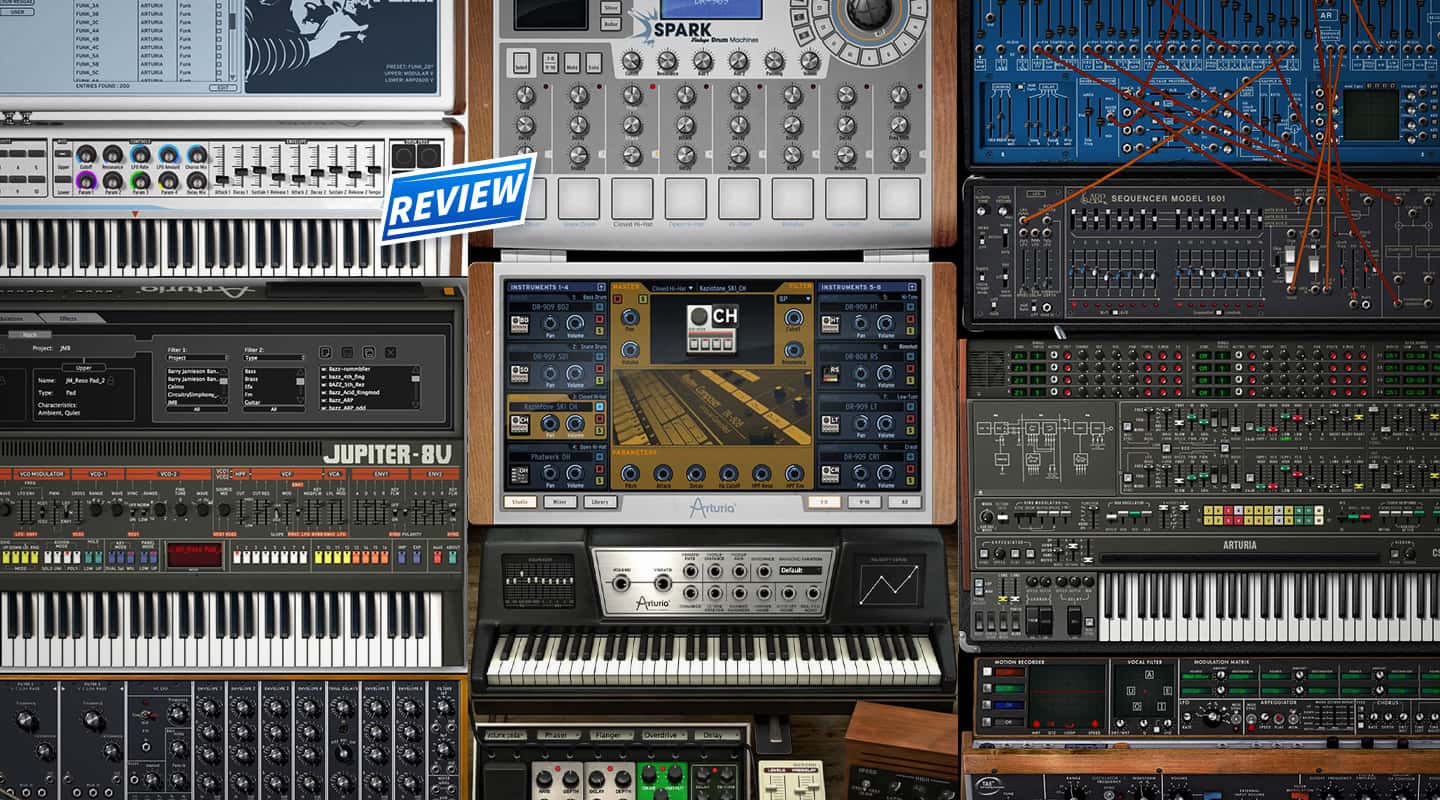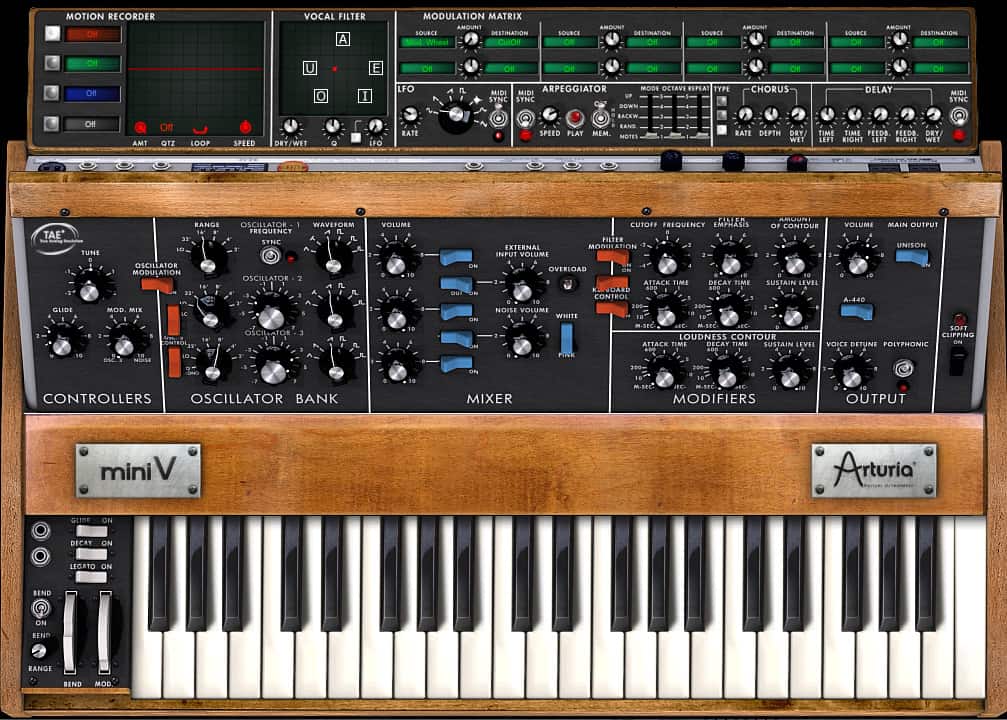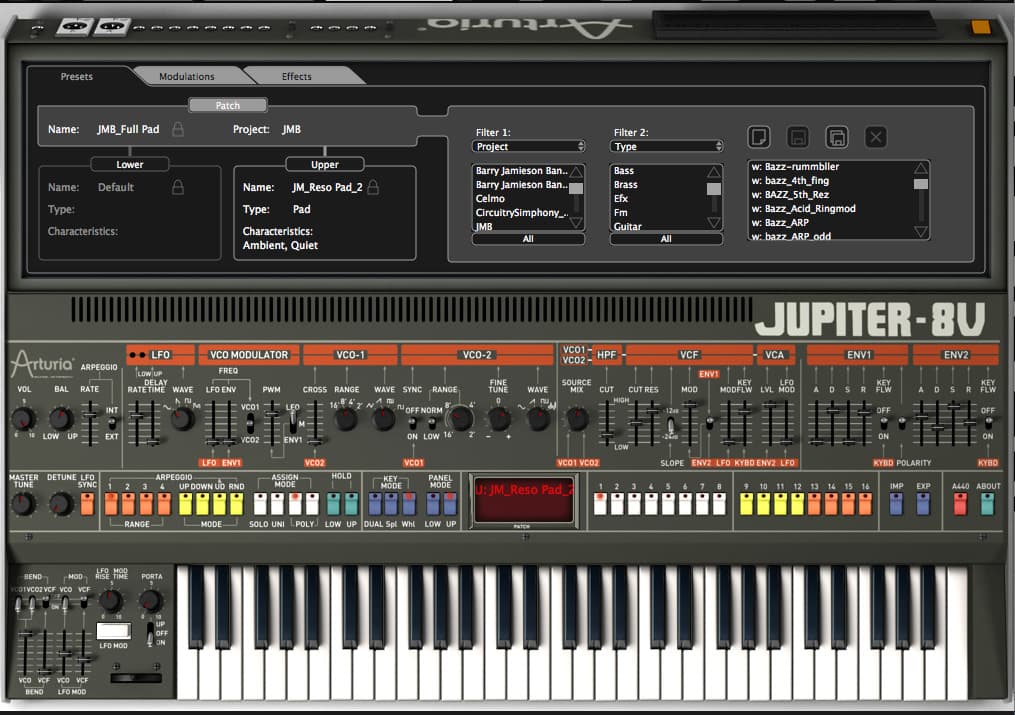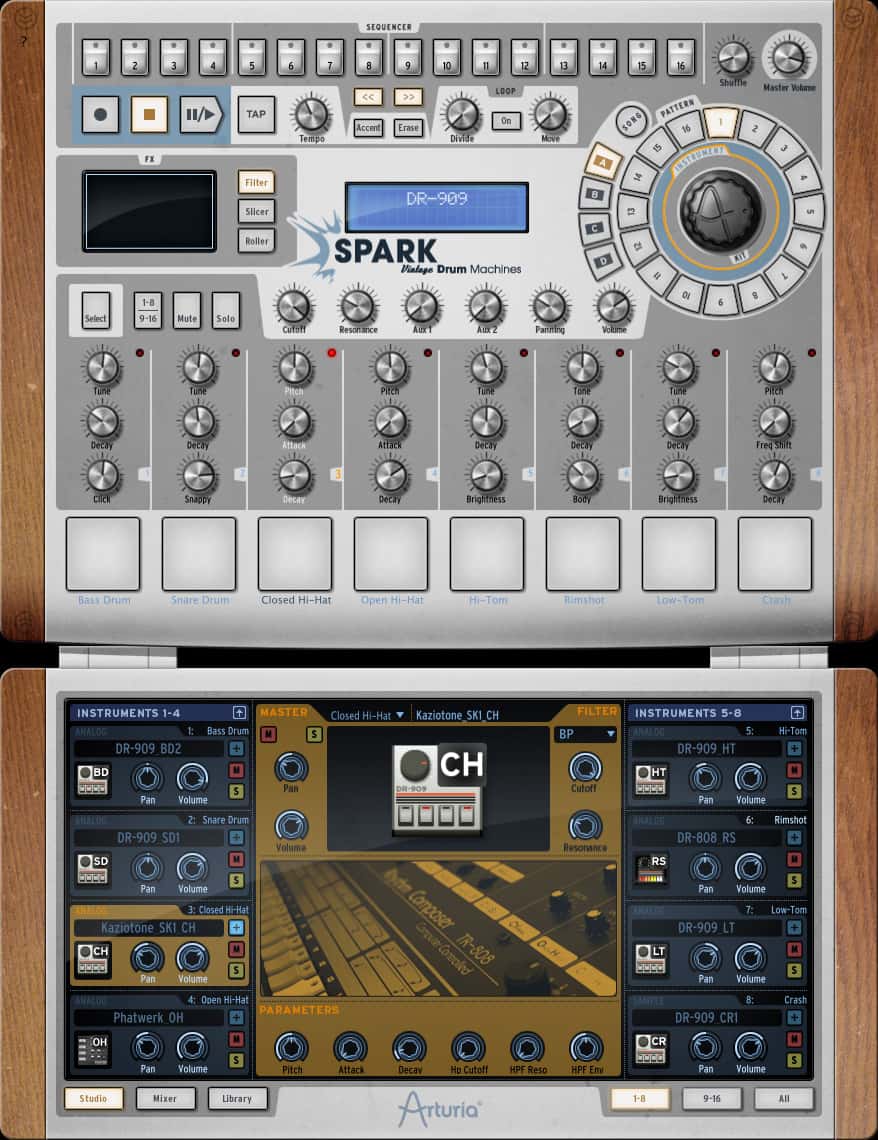
Review: Arturia V Collection 3.0
Arturia has stuffed nine vintage synth emulations and 30 vintage drum machines into its updated V Collection, and given the one-stop production shop a bunch of new moves.
17 October 2013
Review: Robert Clark
The V Collection 3.0 is the latest version of Arturia’s bundle of virtual analogue synths. For the uninitiated, its all about the faithful — almost fanatical — emulation of some of the classic analogue synths that helped shape the music world over the past fifty-odd years. Instruments such as the Moog Modular and Mini Moog, the Prophet V and the CS-80 are responsible for some of the best music — and worst dance-moves — in history, and Arturia are making them available to a new generation of music-makers who probably haven’t touched wood-panelling in their lives.
Each of the synths sound and look pretty convincing in most regards. They are all 32- and 64-bit compatible, work in any DAW as well as in stand-alone mode, and have enough presets to keep you indoors for days. Most of them also possess a new method of selecting between presets called the Sound Map. It offers up a virtual galaxy of presets spread out in space and represented by different shapes and colours according to their characteristics. I first thought this was a bit gimmicky to be honest, but it actually does improve on the usual method of selecting presets, where you scroll down lengthy lists of names and categories. This is just one of the numerous updates and enhancements that Arturia has made to these synths though. Here’s a look at each of them in a bit more detail.
NEED TO KNOW
- PRICE
$499
- CONTACT
CMI: (03) 9315 2244 or cmi@cmi.com.au
- PROS
- Even more incredible value than version 2
- Accurate emulations, even the new Wurly
- Spark modelling allows core tweaks of vintage drum machines
- Additional modes and automation expand palette
- CONS
- Some out of place GUI additions
- SUMMARY
The addition of Wurlitzer V and Oberheim SEM V emulations should be enough to consider the upgrade from version 2. But add the Spark VDM analogue-modelled (not sampled) drum machine, and the inclusion of Analogue Laboratory in the package for convenient mixing and matching of the extensive library, and Arturia’s V Collection 3.0 is an absolute steal. That’s not even going into the extended mode and automation updates.

The Modular V
The famously imposing Moog Modular synth. If you prefer leather elbow-pads to leather jackets, then this is your kind of thing. The first difference users of Arturia’s original reproduction will notice is that you can now see all of the modules on screen at once (provided you’ve got the screen real-estate), which is certainly a lot better for work-flow and those periods of frenetic experimentation where you splash cables about like Jackson Pollock attacking a canvas. Arturia has also added new modules that they’ve either invented or that were once available as additions to the original analogue synth. The Bode Frequency Shifter was one such accessory that, back in the day, could be ordered from the manufacturer to install by yourself at home (when men were men I guess). I found it particularly handy as it allows you to easily and powerfully fatten-up your tones by adding a little phase shifting, or create extra colour by tweaking the rate and scale of tuning frequencies. There’s quite a few additions that weren’t in the original, too, such as Sample and Hold and an Envelope Follower that can be used on external sources.
Simulated cabling is nothing new in music software of course, but I think it’s worth noting that Arturia has done a good job of giving it an authentic feel whilst also adding in some helpful advantages over the real thing. For example, you can insert more than one cable into any input or output, which expands the capabilities of the synth immeasurably and also allows you to make short cuts (purists will not indulge I imagine). Also helpful is that it won’t allow you to insert a cable where it doesn’t belong, such as linking two inputs for example, which I imagine will save novices and pros alike many hours of head-scratching in the wee hours of the morning.
The Mini V
If you’d prefer to work with three oscillators instead of the Modular’s nine, and you prefer a few knobs and dials to a maze of cables, the Mini V is a good option. This is of course, why it became so popular and why we’ve been hearing it in the pop world from the seventies right up to now. When you start playing with the Mini V you also appreciate how simply it’s laid out. Unlike the Moog Modular, it’s also quite easy to plot the path of your signal and keep track of your tweaks. So everything is there that current or past owners of the analogue synth will expect, plus a couple of extra buttons such as an on/off switch for polyphony, soft-clipping, unison and legato. You can’t escape the major addition, however, which is the panel that pops up when you’re in ‘extended mode.’ Here you can play with some pretty impressive modulation tools, such as the Motion Recorder which displays a graphic interface that gives you the ability to draw freehand envelopes in real-time to manipulate up to four different parameters. I found this to be a lot of fun, and handy in that you can begin creating very complex sounds straight away — as soon as you’ve selected what type of waveform you want to build from. Also included in extended mode is a formant filter called the Vocal Filter, which I also found to be a very quick and powerful tool; particularly with the addition of a hard-wired LFO that can easily automate variation within it. Other bonuses include an extra LFO, arpeggiator, chorus and delay FX, and a Modulation Matrix which allows for up to eight modulation connections from a variety of sources including externals.


The CS-80 V
For me the CS-80 is one of those synths that you just want to touch. Setting aside the famous sounds that have emanated from it (Stevie Wonder, Brian Eno etc.), those daggy, brightly coloured paddles just beg to be fondled, and the ribbon controller is much more satisfying to use with your fingertips than a mouse. Still, very few of us are lucky enough to own the real thing, so if there is a good emulation of one out there it’s worth knowing about. The CS-80 V seems about as close as you could get to the real thing. It looks and sounds as good as I could have hoped (well, it passed my “do I feel like I’m Vangelis scoring an eighties sci-fi film?”-test). It is a bit curious that those terrifically cheap-looking but indispensable preset buttons that were originally (ambitiously?) labelled Clavichord, Guitar, Harpsichord etc have been replaced with just the numbers 1 to 12. I’m not sure if it was a resolution thing but it would’ve been nice to see them stay, not just for reasons of nostalgia but because they were always useful as an anchor point for building sounds.
In addition to all of the standard features, Arturia has significantly beefed up its multi-timbral capability with a modulation matrix that allows you to re-direct sounds from 12 different sources to 38 different destinations for up to 10 different modulations. So you can route LFOs, EQ filters and even the ribbon to frequency envelopes, noise generators, VCOs or VCAs with relative ease, just don’t forget to sleep at some point. There’s also a Multi-Mode which allows you to assign sounds to each of your polyphonic voices and also to create a key-map; which seems a particularly good idea. I am a fan of the functionality of this addition and also the way in which Arturia has made the whole panel ‘fit-in’ stylistically.
The Jupiter 8V
I first encountered the Jupiter 8 when my music-technology lecturer wowed his class of music-nerds and BA weirdos with its acoustic charms. The first thing we did was make a bird-call, which wasn’t exactly ‘phat,’ but it did show me that this synth is capable of some very cool sound design in addition to the rich musical tones you hear from Depeche Mode to Moby. So it’s many different things to many different people, which is testament to its flexibility and power. Unlike other synths in the V Collection 3.0, the extras that Arturia has created for the Jupiter 8 soft-synth haven’t been embedded so lovingly into the virtual console. The ‘extension panel’ appears smoothly from behind the original edifice, but it looks decidedly digital and takes away from the whole vintage feel in my opinion. But that’s really being picky. For me one of the highlights of this extra panel lies within the modulations tab, where there is an effect called Galaxy. It includes three interconnected LFOs that modify different parameters on an X and Y axis, which sounds complicated, but once you get in there and have a play you discover some great effects, and the little graphic display helps a bit in figuring out what you’re doing. There’s also a step sequencer which I found to have some cool options, such as being able to hand draw envelopes along your sequence to shape melody or a number of other parameters.


The Prophet V
The original Prophet V was and remains incredibly popular, but anyone who has owned one will testify to its susceptibility to de-tuning and the difficulty in repairing any faults. Not to mention the lack of MIDI in/out of course. The beautiful thing about software synths is that those issues are no longer present and, at least in theory, we’re all free to just create to our heart’s content. Perhaps the biggest advantage of Arturia’s Prophet 5, though, is that it comes bundled with the Prophet VS, which can be used independently or as a hybrid unit with the 5. So it’s almost exponentially superior to either original model in terms of programming power and flexibility. The original Prophet VS was also a tricky beast to program, mostly because all the modulation was happening underneath a panel of bland buttons with limited information appearing on its tiny screen. I found Arturia’s re-imagining of the interface a bit more friendly, although the modulation matrix took a bit of head-scratching. Still present, though, is the joystick for mixing your four oscillators together, which is both very effective and quintessentially ’80s in style. Thank God they kept that in.
The Oberheim SEM V
This is, in effect, the expansion of an expansion module, so as you can imagine there is a lot of sonic possibilities offered here. As much as the Synthesiser Expander Module was capable of enhancing other synths, it was its own sounds that made it famous, so if Arturia didn’t get that right they would’ve been in trouble. Consequently they seem to have paid a lot of attention to the multimode 12dB/octave filter responsible for those sounds and the result is quite impressive. You can pretty quickly find those bass lines that made the SEM famous, which is the real acid test I think. Also, the simplicity of the original unit’s layout was a true thing of beauty, so it’s great to see that Arturia has kept that understated yet powerful feel with the SEM V by only adding one panel on either side for their additional effects knobs. Arturia has also hidden its fancy new modulations and effects features on a pop-up screen display that can be hidden (although, like the Jupiter 8V, it doesn’t fit stylistically). It could have been much worse. When Tom Oberheim and his associates first decided to expand the module’s capability to eight-voice polyphony, the result was a mammoth unit that basically welded together eight individual SEMs, which on paper made sense I guess, but in practical terms was pretty insane. Using the SEM V in its basic form is simply joyful. I think part of Oberheim’s success was that he combined powerful modulation possibilities with a straight-forward, pleasing user experience, and for my money, that has been nicely retained here.


The Wurlitzer V
There are lots of thoughtful features in the Wurlitzer V that are worth a mention. It’s one of those instruments that’s brilliant in the real world but has been sub-par in the virtual, so Arturia have made an effort to give as much authenticity to the experience as they can, which I for one appreciate. For example, you can toggle the amount of hardness and/or noise of the key hammers, and even note-off and pedal noise. These features will really help if you’re writing something that has to feel ‘grounded’ in your mix. On that note, the fact that you can choose your output to be either direct, or coming out of a Leslie or guitar amp, is pretty useful, and if you go the amp option you can choose from a couple of well-known mics on or off axis. The choice of mics, amps and positions is somewhat limited, but at least you have them right there within the interface. Effects are housed in pedals that appear below the keyboard itself, which I thought was a nice touch, and the sounds you get from it — arguably the most important feature — are convincingly rich, dirty, and everything else a Wurlitzer needs to be. It’s so much fun toggling through the presets, which are comprehensive in terms of style and variation, that you can and will spend many, many hours beating your MIDI keyboard senseless. For me this is a real highlight of the package.
The ARP2600 V
Imagine the hide I’d have to give an appraisal of this semi-modular synth’s merits. It’s one of the most lauded analogue machines in the history of music. On a fundamental waveform level, to me the replicated tones are very convincing. Notable is that the famous 16-step sequencer, the ‘1601’ is included by default, and as far as the original features are concerned, it’s all there. In addition you’ll find chorus and delay effects and a module that pretty much is the Mini V’s Motion Recorder but they’ve called it the ‘Tracking Generator’ and made it fit aesthetically with the overall look of the synth.


The Analogue Laboratory
There really is such a thing as too much choice, and with nine vintage synths to decide between you’d go mad trying to find the exact sound you’re looking for by going through them one by one. Therefore, were I to be the owner of a V Collection 3.0, I would start with the Analogue Factory. I can’t recommend it highly enough, in fact. Not only does it lay out a library of every preset for every synth in the collection according to sound type and characteristics, but you can play, edit and key-split those sounds within the plug-in itself. If you want to go more in depth, you can also just open the synth responsible for that sound right alongside the Laboratory. There are standard controls within it, too, such as cut-off, resonance, chorus and delay, as well as two ADSR envelopes, so if you want to choose something quickly and make minor tweaks it’s very easy to do. Basically it acts like the mothership of your collection but is playable and powerful enough to be a solid stand-alone synth.
The Spark VDM
This is the vintage and software-only version of the Spark Creative Drum Machine. And just like its hardware/software sister, it emulates analogue kits rather than samples them, which means you can effectively tweak your favourite vintage sounds from their foundations; resulting in a more authentic response. When I affected the pitch of a bass drum or snare, for example, the tone remained satisfyingly pure. It’s well set-up for live performance as well. The centre module is clearly designed for creating on the fly, with an embedded FX screen offering powerful filter, slicer and roller effects that are easy to modulate in real-time. Another cool feature for me was that you don’t have to settle for the individual preset sounds within a specific kit. You can choose an 808 bass drum with a Linn snare for example, and the entire library of individual sounds is accessible in the bottom slide-out panel. There is of course a step-sequencer, good MIDI integration, song and pattern mode, a mixer and a great library of famous drum-machines. The key thing for many people, though, will be its analogue emulation and live play features, which I think will impress nine times out of 10.

So, a pretty comprehensive collection, and for my money, the technology is impressive and the synths are convincingly rendered. If you’re after the classic analogue sound that was responsible for so many embarrassing dance-floor moments in your youth, I don’t think you’d be disappointed. And if you want to tweak the hell out of those original tones to erase the past and forge new territory, there’s plenty of scope to do that as well.
















RESPONSES